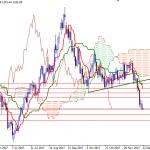Last week, a number of Fed Presidents made speeches that contained their respective analysis of the economy.
Here is a brief summation of Fed President Lacker’s analysis of the US economy:
Consumer spending, residential investment, overall business investment and government spending are likely to contribute to continued GDP growth of about 2.2 percent in the near term. In the next few years, GDP growth is likely to converge to about 1 ¾ percent.
There is no debate regarding consumer spending; while the Y/Y pace of growth is slower than previous expansions, the consumer is spending. And residential investment is a very important harbinger of future growth. However, overall business investment, while positive, has been a bit weaker since 1Q13 on a Y/Y basis:

And with overall capacity utilization not only at lower levels than previous expansions but also declining, it’s doubtful this type of spending will increase above current levels.
Fed President Lockhart had a similar view of the economy, although instead of focusing on housing he based his positive view of the consumer on the healthy state of the auto sales market. He argued the weak state of the oil market caused weak business investment. He also stated external markets (China, emerging economies and weak oil) provided the primary risk to the US. His speech contained the following key points:
New Dallas Fed President Kaplan offered a very interesting view on the economy.He first noted that his preferred inflation measure was the trimmed mean CPI as calculated by the Dallas Fed, which is currently between 1.6% and 1.7% — a bit higher than other more commonly used measures.He also stated he was concerned about China and emerging economies.Finally, he stated the following areas were his primary areas of focus:

















Leave A Comment